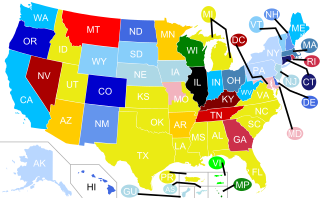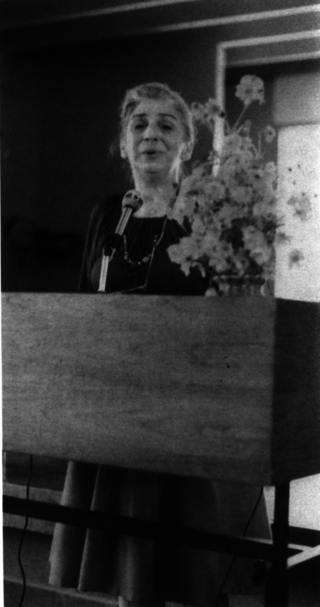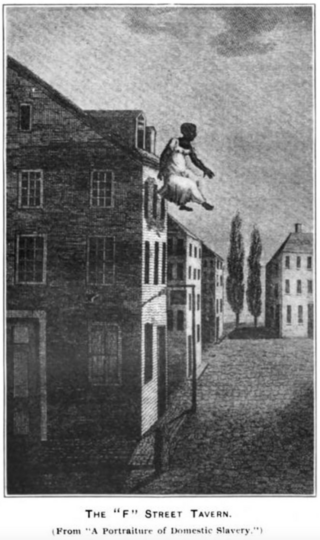
The United States courts of appeals are the intermediate appellate courts of the United States federal judiciary. The courts of appeals are divided into 11 numbered circuits that cover geographic areas of the United States and hear appeals from the U.S. district courts within their borders, the District of Columbia Circuit, which covers only Washington, D.C., and the Federal Circuit, which hears appeals from federal courts across the United States in cases involving certain specialized areas of law. The courts of appeals also hear appeals from some administrative agency decisions and rulemaking, with by far the largest share of these cases heard by the D.C. Circuit. Appeals from decisions of the courts of appeals can be taken to the U.S. Supreme Court.
Separate but equal was a legal doctrine in United States constitutional law, according to which racial segregation did not necessarily violate the Fourteenth Amendment to the United States Constitution, which nominally guaranteed "equal protection" under the law to all people. Under the doctrine, as long as the facilities provided to each "race" were equal, state and local governments could require that services, facilities, public accommodations, housing, medical care, education, employment, and transportation be segregated by "race", which was already the case throughout the states of the former Confederacy. The phrase was derived from a Louisiana law of 1890, although the law actually used the phrase "equal but separate".

Sodomy laws in the United States, which outlawed a variety of sexual acts, were inherited from colonial laws in the 17th century. While they often targeted sexual acts between persons of the same sex, many statutes employed definitions broad enough to outlaw certain sexual acts between persons of different sexes, in some cases even including acts between married persons.
Bolling v. Sharpe, 347 U.S. 497 (1954), is a landmark United States Supreme Court case in which the Court held that the Constitution prohibits segregated public schools in the District of Columbia. Originally argued on December 10–11, 1952, a year before Brown v. Board of Education, Bolling was reargued on December 8–9, 1953, and was unanimously decided on May 17, 1954, the same day as Brown. The Bolling decision was supplemented in 1955 with the second Brown opinion, which ordered desegregation "with all deliberate speed". In Bolling, the Court did not address school desegregation in the context of the Fourteenth Amendment's Equal Protection Clause, which applies only to the states, but rather held that school segregation was unconstitutional under the Due Process Clause of the Fifth Amendment to the United States Constitution. The Court observed that the Fifth Amendment to the United States Constitution lacked an Equal Protection Clause, as in the Fourteenth Amendment to the United States Constitution. However, the Court held that the concepts of equal protection and due process are not mutually exclusive, establishing the reverse incorporation doctrine.

William Cranch was a United States circuit judge and chief judge of the United States Circuit Court of the District of Columbia. A staunch Federalist and nephew of President John Adams, Cranch moved his legal practice from Massachusetts to the new national capital, where he became one of three city land commissioners for Washington, D.C., and during his judicial service also was the 2nd Reporter of Decisions of the Supreme Court of the United States and a Professor of law at Columbian College.
The Midnight Judges Act represented an effort to solve an issue in the U.S. Supreme Court during the early 19th century. There was concern, beginning in 1789, about the system that required the Justices of the Supreme Court to "ride circuit" and reiterate decisions made in the appellate level courts. The Supreme Court Justices had often expressed concern and suggested that the judges of the Supreme and circuit courts be divided. The Act was repealed by Congress on January 22, 1802.
The United States circuit courts were the intermediate level courts of the United States federal court system from 1789 until 1912. They were established by the Judiciary Act of 1789, and had trial court jurisdiction over civil suits of diversity jurisdiction and major federal crimes. They also had appellate jurisdiction over the United States district courts. The Judiciary Act of 1891 transferred their appellate jurisdiction to the newly created United States circuit courts of appeals, which are now known as the United States courts of appeals. On January 1, 1912, the effective date of the Judicial Code of 1911, the circuit courts were abolished, with their remaining trial court jurisdiction transferred to the U.S. district courts.

Mary Church Terrell was one of the first African-American women to earn a college degree, and became known as a national activist for civil rights and suffrage. She taught in the Latin Department at the M Street School —the first African American public high school in the nation—in Washington, DC. In 1895, she was the first African-American woman in the United States to be appointed to the school board of a major city, serving in the District of Columbia until 1906. Terrell was a charter member of the National Association for the Advancement of Colored People (1909) and the Colored Women's League of Washington (1892). She helped found the National Association of Colored Women (1896) and served as its first national president, and she was a founding member of the National Association of College Women (1923).
Bell v. Maryland, 378 U.S. 226 (1964), provided an opportunity for the Supreme Court of the United States to determine whether racial discrimination in the provision of public accommodations by a privately owned restaurant violated the Equal Protection and Due Process Clauses of the 14th Amendment to the United States Constitution. However, due to a supervening change in the state law, the Court vacated the judgment of the Maryland Court of Appeals and remanded the case to allow that court to determine whether the convictions for criminal trespass of twelve African American students should be dismissed.
Barr v. City of Columbia, 378 U.S. 146 (1964), is a United States Supreme Court decision that reversed the breach of peace and criminal trespass convictions of five African Americans who were refused service at a lunch counter of a department store. The Court held that there was insufficient evidence to support the breach of peace convictions, and reversed the criminal trespass convictions for the reasons stated in another case that was decided that same day, Bouie v. City of Columbia, which held that the retroactive application of an expanded construction of a criminal statute was barred by due process of ex post facto laws.
United States v. More, 7 U.S. 159 (1805), was a United States Supreme Court case in which the Court held that it had no jurisdiction to hear appeals from criminal cases in the circuit courts by writs of error. Relying on the Exceptions Clause, More held that Congress's enumerated grants of appellate jurisdiction to the Court operated as an exercise of Congress's power to eliminate all other forms of appellate jurisdiction.

Annie Stein was a civil rights activist who focused on desegregating Washington, D.C. theaters, restaurants and department stores.
Corrigan v. Buckley, 271 U.S. 323 (1926), was a US Supreme Court case in 1926 that ruled that the racially-restrictive covenant of multiple residents on S Street NW, between 18th Street and New Hampshire Avenue, in Washington, DC, was a legally-binding document that made the selling of a house to a black family a void contract. This ruling set the precedent upholding racially restrictive covenants in Washington; soon after this ruling, racially restrictive covenants flourished around the nation. Subsequently, in Shelley v. Kraemer (1948) the court reconsidered such covenants and found that racially restrictive covenants are unenforceable.
Gardner L. Bishop was a barber and civil rights activist in Washington, D.C. His work for equal schools for black and white children in the 1940s and 1950s included organizing the student strike at Browne Junior High School and contributing to the historic Bollingv. Sharpe case that made school segregation unconstitutional in the District. Bishop, originally from North Carolina, was known for his outspokenness and his drive to end elitism in the black community.
Hobson v. Hansen, 269 F. Supp. 401, was a federal court case filed by civil rights activist Julius W. Hobson against Superintendent Carl F. Hansen and the District of Columbia's Board of Education on the charge that the current educational system deprived Black people and the poor of their right to equal educational opportunities relative to their white and affluent counterparts, on account of race and socioeconomic status. Having established de jure segregation unconstitutional in Bolling v. Sharpe (1954), the federal court addressed questions of de facto segregation in D.C. schools, seen in the trends that survived legal desegregation, in Hobson v. Hansen. Judge J. Skelly Wright's decision, in favor of the plaintiffs, sought to remedy the re-segregation or de facto segregation enforced by the educational policies, including tracking and optional-transfer zones, adopted by the Board of Education in an attempt to accommodate the consequences of the shift to integrated schools in the aftermath of Bolling, and within the wider context of emerging racially and socioeconomically rigid residential patterns.
Joseph Forer was a 20th-century American attorney who, with partner David Rein, supported Progressive causes, including discriminated communists and African-Americans. Forer was one of the founders of the National Lawyers Guild and its DC chapter. He was also an expert in the "Lost Laws" of Washington, DC, enacted in 1872–1873, that outlawed segregation at business places.
Hubert B. Pair was a judge of the District of Columbia Court of Appeals, the highest court for the District of Columbia.
David Rein (1914–1979) was a 20th-Century American attorney who, with partner Joseph Forer, supported Progressive causes including the legal defense of African-Americans and accused Communists. Rein and Foyer were members of the National Lawyers Guild and its D.C. chapter. Rein represented "more than 100 people", alleged to have been Communists, before the House Un-American Activities Committee (HUAC) and the subcommittee of the Senate Committee on Administration.

Anna "Ann" Williams was an enslaved woman who successfully sued for freedom for herself and her children before the United States Court of Appeals for the DC Circuit. Her lawsuit and her infamous jump from the window of the F Street Tavern heightened public awareness of the terror and suffering caused by the slave trade in the United States.






